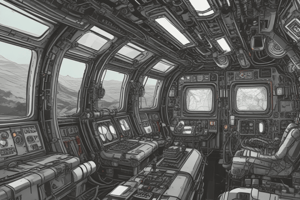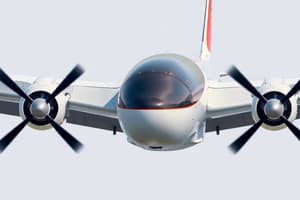Podcast
Questions and Answers
What is the primary reason for deploying slats in conjunction with flaps on large transport category aircraft?
What is the primary reason for deploying slats in conjunction with flaps on large transport category aircraft?
- To decrease the overall camber of the wing, reducing drag during landing.
- To reduce the stall angle, thus ensuring the aircraft can land at higher speeds.
- To increase the stall angle and lift coefficient by energizing airflow over the wing. (correct)
- To minimize the increase in lift coefficient caused by flaps, maintaining consistent handling characteristics.
How do fuselage-installed aerodynamic brakes primarily function?
How do fuselage-installed aerodynamic brakes primarily function?
- By increasing drag. (correct)
- By decreasing drag and increasing lift.
- By increasing lift and decreasing drag.
- By decreasing both lift and drag.
During which flight maneuver is the 'ground spoiler' function typically activated?
During which flight maneuver is the 'ground spoiler' function typically activated?
- During rapid descent to increase drag.
- During takeoff to reduce ground speed.
- During cruise to adjust altitude.
- Upon landing, after both main landing gear legs are compressed. (correct)
What distinguishes the function of spoilers used as 'speed brakes' from their function as 'ground spoilers'?
What distinguishes the function of spoilers used as 'speed brakes' from their function as 'ground spoilers'?
Which of the following correctly describes the effect of deploying flaps on the stall angle of an aircraft?
Which of the following correctly describes the effect of deploying flaps on the stall angle of an aircraft?
If a pilot commands a roll order during approach, what happens to the speed brake function?
If a pilot commands a roll order during approach, what happens to the speed brake function?
What is the primary purpose of secondary flight controls in an aeroplane?
What is the primary purpose of secondary flight controls in an aeroplane?
Why is increasing the camber of a wing an effective way to increase lift?
Why is increasing the camber of a wing an effective way to increase lift?
What is a key benefit of using flaps on the trailing edge of a wing?
What is a key benefit of using flaps on the trailing edge of a wing?
What typically happens when flaps are deflected to their maximum extent without the use of leading edge slots or slats?
What typically happens when flaps are deflected to their maximum extent without the use of leading edge slots or slats?
What best describes the functionality of plain flaps?
What best describes the functionality of plain flaps?
In aircraft design, what does the need to compromise between stability and maneuverability suggest?
In aircraft design, what does the need to compromise between stability and maneuverability suggest?
What is the relationship between aerodynamic lift and the shape and size of a wing's aerofoil section?
What is the relationship between aerodynamic lift and the shape and size of a wing's aerofoil section?
What are slots and flaps primarily used for in aircraft design?
What are slots and flaps primarily used for in aircraft design?
What is the main reason plain flaps are seldom found on modern aeroplanes?
What is the main reason plain flaps are seldom found on modern aeroplanes?
Which type of flap is characterized by a portion of the lower surface of the wing's trailing edge hinging down into the airstream, significantly increasing drag at low lift coefficients?
Which type of flap is characterized by a portion of the lower surface of the wing's trailing edge hinging down into the airstream, significantly increasing drag at low lift coefficients?
What is the primary advantage of using slotted flaps on an aircraft wing?
What is the primary advantage of using slotted flaps on an aircraft wing?
How do Fowler flaps primarily enhance lift during their initial deployment phase?
How do Fowler flaps primarily enhance lift during their initial deployment phase?
What is a flaperon, and how does it function on an aircraft?
What is a flaperon, and how does it function on an aircraft?
What is the purpose of leading edge flaps on high-performance aircraft?
What is the purpose of leading edge flaps on high-performance aircraft?
Why are Krueger flaps used on large turbine-engine transports with swept wings?
Why are Krueger flaps used on large turbine-engine transports with swept wings?
How does a drooped leading edge flap function to increase lift?
How does a drooped leading edge flap function to increase lift?
What is the primary function of slots in an aircraft wing?
What is the primary function of slots in an aircraft wing?
What is the primary disadvantage of fixed slots in a wing, especially for high-speed aircraft?
What is the primary disadvantage of fixed slots in a wing, especially for high-speed aircraft?
How do movable slats overcome the limitations of fixed slots on aircraft wings?
How do movable slats overcome the limitations of fixed slots on aircraft wings?
Flashcards
Aeroplane Design Compromises
Aeroplane Design Compromises
Balancing stability, speed, cost, and utility in aircraft design.
Primary Flight Controls
Primary Flight Controls
Controls that rotate the aircraft about its three axes.
Secondary Flight Controls
Secondary Flight Controls
Controls that assist or modify the effect of primary controls.
Aerodynamic Lift
Aerodynamic Lift
Signup and view all the flashcards
Flaps
Flaps
Signup and view all the flashcards
Trailing Edge Flaps
Trailing Edge Flaps
Signup and view all the flashcards
Leading Edge Slots
Leading Edge Slots
Signup and view all the flashcards
Plain Flaps
Plain Flaps
Signup and view all the flashcards
Wing Camber
Wing Camber
Signup and view all the flashcards
Stall Angle
Stall Angle
Signup and view all the flashcards
Lift Coefficient (CL)
Lift Coefficient (CL)
Signup and view all the flashcards
Spoilers
Spoilers
Signup and view all the flashcards
Aerodynamic Brakes
Aerodynamic Brakes
Signup and view all the flashcards
Ground Spoilers
Ground Spoilers
Signup and view all the flashcards
Split Flaps
Split Flaps
Signup and view all the flashcards
Slotted Flaps
Slotted Flaps
Signup and view all the flashcards
Fowler Flaps
Fowler Flaps
Signup and view all the flashcards
Slotted Fowler Flaps
Slotted Fowler Flaps
Signup and view all the flashcards
Flaperons
Flaperons
Signup and view all the flashcards
Leading Edge High-Lift Devices
Leading Edge High-Lift Devices
Signup and view all the flashcards
Krueger Flaps
Krueger Flaps
Signup and view all the flashcards
Drooped Leading Edge Flap
Drooped Leading Edge Flap
Signup and view all the flashcards
Slots
Slots
Signup and view all the flashcards
Drag Coefficient
Drag Coefficient
Signup and view all the flashcards
Study Notes
Aircraft Flight Control Systems
- Aircraft design involves compromises between stability, maneuverability, speed, utility, and cost.
- Primary flight controls manipulate the aircraft about its three axes.
- Secondary controls modify or assist primary controls.
- Secondary controls are retractable, used only when needed.
Aerodynamic Lift and Control
- Wing shape and size determine lift.
- Lift modification is done through slots and flaps.
- Wing camber increase is easier for lift enhancement, especially during takeoff and landing when speed/angle adjustments aren't practical.
- Slots and flaps affect lift, stall, and trim.
Types of Secondary Flight Controls
- Lift Modifiers:
- Trailing-edge high-lift devices (flaps)
- Leading-edge high-lift devices (slots, slats)
- Force Modifiers:
- Assists in controlling primary functions
- Trim Controls:
- adjust balance of lift
- Drag Inducers:
- increase drag to influence flight path.
Trailing Edge Flaps
- Flaps on the trailing edge are the most common lift modifiers.
- Flaps increase lift and drag.
- Flap extension and angles can be adjusted from the cockpit.
- Flap configurations vary.
- Full flap deflection can cause airflow separation, leading to lift loss; slots can prevent separation.
Flap Types
- Plain Flaps: Simple, minimal effect, mainly used for low-speed aircraft
- Split Flaps: Less common today, previously used, produced similar lift change as a plain flap but higher drag.
- Slotted Flaps: Most common modern type, increases lift coefficient significantly, uses a slot to prevent airflow separation at stall. Double/Triple-slotted flaps maximize lift increase without stalling.
- Fowler Flaps: Increases wing area, initial high lift with low drag, but increases drag and turbulence as the flap extends further.
Leading Edge High-Lift Devices
- Leading-edge devices increase camber and allow higher angles of attack before stall.
- Krueger Flaps: Increase camber on swept-wing aircraft for low-speed lift. Electric or hydraulically actuated.
- Drooped Leading Edge Flaps: Alter the leading edge of the wing to improve lift.
- Slots: Improve airflow at high angles of attack and low speeds, slightly increase drag.
Aircraft Flaps and Slats Behavior
- Slats and flaps together are preferred designs
- Slats increase lift when deployed with flaps
- Slats also increase camber
Aerodynamic Brakes
- Devices that increase drag, reduce lift.
- Wing-installed: Increases drag and reduces lift
- Fuselage-installed: Increases drag
- Used for approach/descent, landing, and ground braking through spoilers
Spoilers
- Destroy lift by disrupting airflow.
- "Speed brake" function on approach and descent to increase drag and control descend rate.
- In landing, spoilers increase braking efficiency by increasing tire/ground contact pressure
Flaperons
- Ailerons that can function as flaps, combine the functions of flaps and ailerons.
- Boeing 767, 777 and 787 use the ailerons as flaperons.
- Function as ailerons during cruise.
- Function as flaperons during landing.
- Function as aileron and spoiler during landing rollout.
Coefficient of Lift (CL) and Stall Angle
- Lowering flaps reduces the stall angle but improves lift at lower speeds.
- Deployment of slats together with flaps restores normal stall angle and increases it beyond flap-less position.
Studying That Suits You
Use AI to generate personalized quizzes and flashcards to suit your learning preferences.
Description
Explore aircraft secondary flight control systems. Secondary controls like flaps, slots and slats modify lift. Trim controls maintain lift balance, while drag inducers adjust the flight path.




